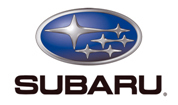Subaru Debuts New EyeSight System
 |
- Stereo Camera Based Driver Assist System
- Pre-Collision Braking
- System Capable of Pedestrian Detection
- Lane Departure and Sway Warning
- Adaptive Cruise Control
- Optional in 2013 Legacy and Outback
FYI: Subaru Buyer's Guide
CHERRY HILL, NJ--March 15, 2012: Subaru of America, Inc. has announced the debut of its EyeSight driver assistance system. The suite of safety and driver assist technologies will debut at the New York International Auto Show on 2013 Legacy and Outback models. EyeSight will subsequently appear on other products in the Subaru line-up. EyeSight integrates adaptive cruise control, pre-collision braking, and vehicle lane departure warning. The new technology, which can also detect obstacles in front of a parked car and limit potential damage in an impact, will become available later this year.
Combining safety and convenience features, the Subaru EyeSight system will be one of the most affordable of such technologies available in the United States market. EyeSight uses two charge-coupled device (CCD) cameras developed by Subaru. EyeSight is mounted inside the car on the upper edge of the windshield, thus reducing the potential for damage that could occur in bumper-mounted systems, such as radar. The EyeSight system processes stereo images to identify the vehicles traveling in front, as well as obstacles, traffic lanes and other items. The video information is relayed to the EyeSight computer, which is also networked with the car's braking system and electronic throttle control. Below speeds of approximately 19mph, EyeSight is capable of detecting pedestrians in the vehicle's path and can activate in order to mitigate or even avoid the collision. Under certain circumstances, Eyesight is able to bring the car to a complete stop, thus avoiding a collision.
Pre-Collision Braking Control and Collision Mitigation
At relative speeds under approximately 19 mph, EyeSight's Pre-Collision Braking System can detect obstacles in the car's path and, if the driver has not applied the brakes in time, the system can do so to slow the vehicle or bring it to a full stop to help avoid the potential collision. Pre-Collision Braking is always on in the background to act like a second set of eyes for the driver. It can also be turned off temporarily for off-road or rough road travel.
At relative speeds above approximately 19 mph, EyeSight can apply the brakes when an object is detected, and will attempt to brake if the driver takes no evasive action, or does not brake appropriately. In this way it will mitigate potential damage from a collision. The system, which can recognize programmed objects such as vehicles, motorcyclists, bicyclists and pedestrians, can help mitigate collision damage.
Lane Departure and Sway Warning
By monitoring traffic lane markers and lines, the Subaru EyeSight system can detect if the car begins to wander outside the intended lane without a turn signal being used, or if the car begins to sway within the travel lane. Using the turn signal cancels the warning.
Adaptive Cruise Control
Intended for freeway use, Eyesight's Adaptive Cruise Control system can maintain a safe distance from the vehicle in front, braking and/or accelerating the car as needed to maintain the driver-selected target speed and traveling distance. Adaptive Cruise Control is operational from 1-87 mph and can fully brake the vehicle to a stop if the system "locks on" to a vehicle ahead.
As an added convenience, Adaptive Cruise Control assists the driver in heavy "stop and go" freeway traffic by maintaining distance from the vehicle ahead. This feature can help reduce driver fatigue, which can therefore help keep the driver alert.
Additional EyeSight Benefits
In heavy traffic conditions, EyeSight will also alert the driver when the vehicle ahead has moved if he or she doesn't react within several seconds. The technology can also help reduce collision damages by cutting the throttle when it senses an obstacle in front, but the accelerator pedal continues to be pushed. The system is also effective when a driver shifts into 'Drive' inadvertently instead of 'Reverse' when backing out of a parking space. The stereo camera design of EyeSight provides a detection angle wider than that of radar-based systems.
Cautions
EyeSight is not designed as a substitute for due care and attention to the road. The system may not react in every situation. There are certain operational limitations, such as when weather conditions obscure the view of the cameras. Finally, even with the advanced technology used, a driver with good vision and who is paying attention will always be the best safety system.


